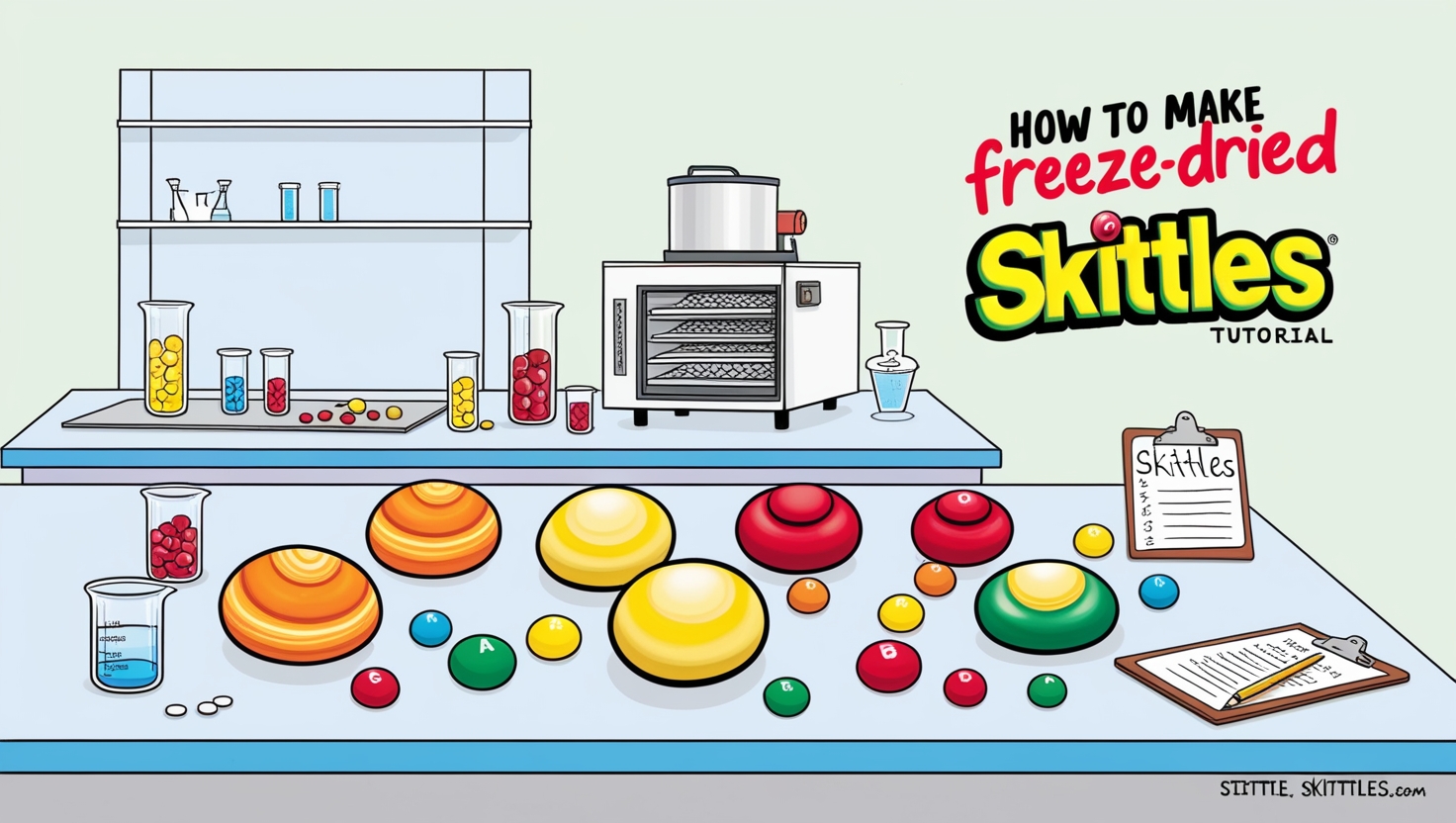Freeze-dried Skittles are not only a fun treat but also an exciting project that can be done at home. The process of freeze-drying candy like Skittles transforms their texture, making them crunchy and enhancing their flavors. In this article, we will guide you through the entire process of making freeze-dried Skittles, from understanding the freeze-dry cycle to best practices for long-term storage. By the end, you will be equipped with all the knowledge you need to master this delightful candy innovation.
What is the Process to Freeze Dry Candy Like Skittles?
Understanding the Freeze Dry Cycle
The freeze-dry cycle is a fascinating process that involves three main stages: freezing, primary drying, and secondary drying. During the freezing stage, you need to freeze the Skittles to a temperature that allows them to crystallize. This step is crucial because it helps to preserve the candy’s flavors and colors. In the primary drying phase, a vacuum is created in the chamber, allowing the ice to sublimate directly into vapor, effectively removing moisture without melting the candy. Finally, in the secondary drying phase, any remaining moisture is eliminated, ensuring that the Skittles become extra dry and crunchy. Understanding this cycle is essential for achieving the perfect batch of freeze-dried Skittles.
Setting Up Your Freeze Dryer
To make freeze-dried Skittles, you will need a reliable freeze dryer—many people opt for the Harvest Right freeze dryer for its user-friendly operation. Setting up your freeze dryer involves placing it on a flat surface, ensuring proper ventilation, and connecting it to a power source. Familiarize yourself with the controls and settings of your freeze dryer, as this will play a significant role in customizing the freeze-dry process. Make sure to close and lock the door securely before starting the cycle to prevent air leaks that could compromise the drying process.
Loading the Tray with Skittles
Once your freeze dryer is set up, it’s time to prepare for loading the tray with Skittles. Start by arranging the Skittles in a single layer on the tray, ensuring that they do not touch each other. This spacing allows the Skittles to freeze evenly and prevents moisture accumulation. You may want to skip this step if you’re planning to load multiple trays, as this could lead to uneven freeze-drying. After loading, close the drain valve and proceed to start the freeze-dry cycle.
How Do You Make Freeze Dried Skittles at Home?
Choosing the Right Equipment for Freeze Drying
When it comes to making freeze-dried Skittles at home, choosing the right equipment is essential. A Harvest Right freeze dryer is a popular choice among home enthusiasts for its efficiency and ease of use. You will also need airtight containers for storage, such as Mylar bags or mason jars, which are perfect for keeping your freeze-dried candy fresh. Additionally, ensure that you have oxygen absorbers on hand, as they can further help in maintaining flavor and crunchiness during storage.
Step-by-Step Instructions for Making Freeze Dried Skittles
Making freeze-dried Skittles involves a series of straightforward steps. First, prepare your freeze dryer and load the tray with Skittles as previously mentioned. Select the candy mode on your freeze dryer, which is specifically designed for processing sugary treats like Skittles. Set the appropriate temperature and freeze time based on the size of your batch; typically, a freeze time of around 2 hours is sufficient. Once the cycle is complete, open the door and remove the trays, and check for any remaining moisture. If they feel chewy or gummy, consider adding extra dry time to ensure they reach the desired crunchy texture.
Customizing Your Freeze Dry Settings
Customizing your freeze-dry settings can significantly impact the final product. Depending on the humidity of your environment and the specific characteristics of the Skittles, you may need to adjust the temperature mode and freeze time. If you notice that your Skittles are not as crunchy as you’d like, it may be beneficial to increase the drying time or opt for an option to warm the trays slightly during the secondary drying phase. Each batch may require slight modifications, so take notes and adjust accordingly for future attempts.
What Are the Best Practices for Storing Freeze Dried Candy?
Optimal Storage Conditions for Freeze Dried Skittles
Once your Skittles are freeze-dried, proper storage is crucial for maintaining their quality. The optimal storage conditions involve keeping the freeze-dried Skittles in a cool, dark, and dry environment. Light and heat can degrade the flavors, so it’s best to store them in a pantry or cupboard. Avoid exposing them to moisture, as this can lead to a chewy texture that detracts from their crunchy experience.
How to Maintain Flavor and Crunchiness
To maintain the delicious flavor and crunchy texture of your freeze-dried Skittles, you should use airtight containers for storage. Oxygen absorbers are beneficial as they help to prevent oxidation, which can alter the candy’s taste. When sealing your containers, ensure that they are tightly closed to block out any air or moisture. Regularly check your stored Skittles for any signs of moisture or degradation, and consume them within the recommended timeframe for the best flavor experience.
Using Airtight Containers for Long-Term Storage
Airtight containers, such as Mylar bags or mason jars, are ideal for the long-term storage of freeze-dried candy. These containers can help to maintain the freshness of your Skittles for months or even years. When using Mylar bags, consider sealing them with a heat sealer to create an airtight environment. For mason jars, ensure that you have proper lids that fit securely. This way, your freeze-dried Skittles will stay ready for snacking without losing their delightful crunch or flavor.
What are the Common Issues When Making Freeze Dried Skittles?
Dealing with Moisture and Texture Problems
Sometimes, while making freeze-dried Skittles, you may encounter moisture or texture problems. If your Skittles feel chewy or gummy after the process, it often indicates that they have not been dried long enough or that moisture has entered during storage. To remedy this, you can run them through another freeze-drying cycle or increase the drying time. Always ensure that the drain valve is closed during the cycle to maintain the vacuum’s integrity, which is essential for effective freeze-drying.
How to Avoid Chewy or Gummy Freeze Dried Skittles
Avoiding chewy or gummy freeze-dried Skittles comes down to proper monitoring of the freeze-drying process. If you notice that the Skittles expand during freezing, this is normal, but be vigilant to ensure they dry completely. Running a batch through the freeze dryer longer than the initial setting may help. If you find that some Skittles are still chewy, consider skipping the first drying cycle and adding an extra dry time in your next attempt to achieve that desired crunchiness.
Adjusting Freeze Time for Perfect Results
Adjusting freeze time is crucial for achieving perfect results when making freeze-dried Skittles. Each batch may require different drying times based on their initial moisture content and your environment’s humidity levels. If your Skittles are not drying properly, it’s worth experimenting with longer freeze times. Keeping a log of your settings can help you refine the process over time, leading to more consistent and satisfying results.
Can You Freeze Dry Other Types of Candy?
Exploring Other Candies to Freeze Dry
While Skittles are a popular choice for freeze-drying, many other types of candy can also be successfully freeze-dried. Options include gummy bears, taffy, and marshmallows, all of which undergo interesting transformations during the freeze-drying process. Each candy has its unique characteristics, and exploring different types will allow you to discover new flavors and textures to enjoy.
Comparing the Process for Different Candy Types
The process for freeze-drying various candies can differ based on their composition. For example, gummy candies may require different settings than chocolate or hard candies. It’s essential to adjust your freeze-dry cycle accordingly, as some candies may need longer freeze times or specific temperature modes. By understanding the properties of each candy type, you can optimize your freeze-drying process for each batch.
Flavor Variations with Different Candies
Freeze-drying opens the door to exciting flavor variations. When you freeze dry different types of candy, you can experience intensified flavors and unique textures. For instance, freeze-dried chocolate may become crunchy and intensely chocolate-flavored, while fruit-flavored candies might taste even more vibrant. Experimenting with various candies will lead to delicious discoveries and allow you to customize your freeze-dried treats to your liking.

